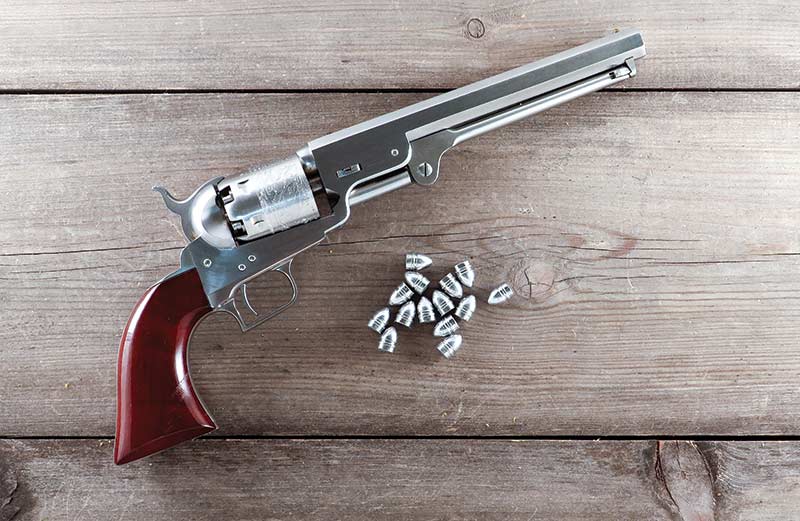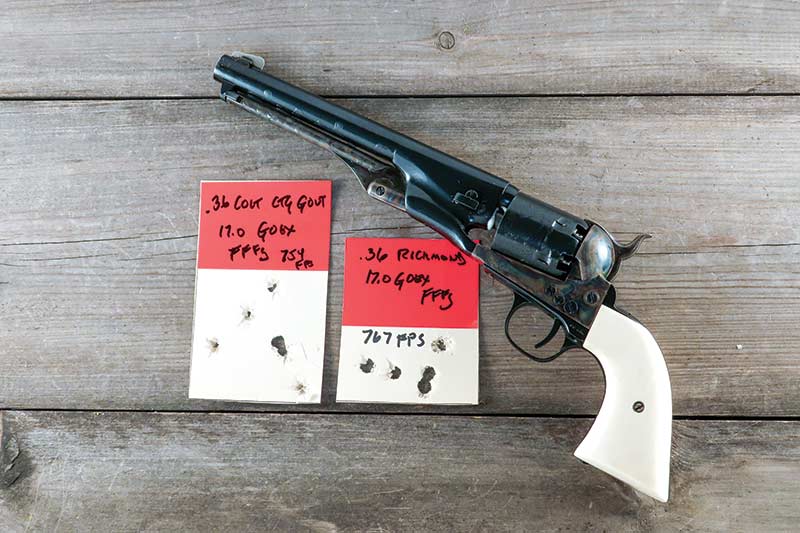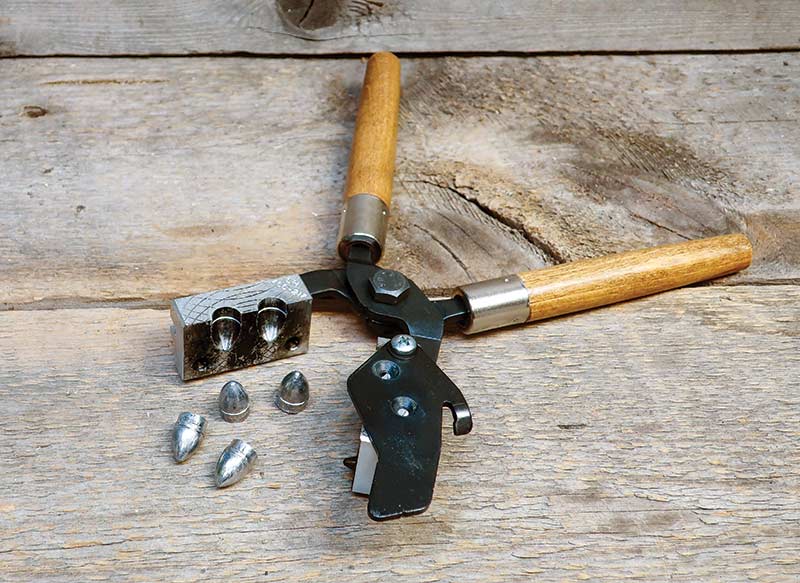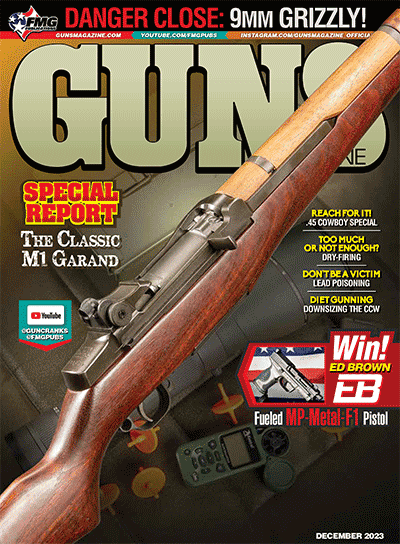Handloading for Black Powder:
Percussion 36s
The .36 Model 1851 Navy was dwarfed by the power afforded by the .44 Dragoons. Firing 90-grain round ball at about 900 fps, energy-wise, realistically puts it into the category of today’s .380 ACP. But, it was easy to holster and carry on a belt with its 2 ½ lb. weight and was a real step up from the .31 Pocket Pistol.
Along with the .44 Model 1860 Army, the .36 Model 1851 Navy was used by the North in the 1860s and in both cases the troops were provided with conical bullet loads in paper or skin cartridges. At the end of the war, the U.S. Military had nearly 2 million paper cartridges on hand loaded with conical bullets for the Navy Model. The cartridges were normally issued in packs of six wrapped in heavy paper or in pine or basswood blocks with a hole drilled to accept each cartridge. Some of these were also packed with six percussion caps.
At The Range
For my use with the .36 percussion sixguns, I have access to a pair of conical bullets from Eras Gone. These are the .36 Colt Cartridge Works and the .36 Richmond Laboratory design. The former was designed by Colt in the late 1850s with a weight of approximately 126 grains and a tapered heel to make insertion into the cylinder chamber easy. This heel also provided the surface area for attaching a paper cartridge. Colt produced millions of these and sold them to the United States Army. The latter .36 bullet was designed at the Confederate Arsenal in Richmond, Va. These also have the tapered heel and weigh right at 147 grains. These are cast-it-yourself projects; however, Kaido Bullets offers a flat-nosed Kaido bullet complete with grease grooves and weighing right at 145 grains.
Eras Gone specializes in providing historically accurate replicas of bullets from the percussion era and these are produced by Lee in double-cavity persuasion and only available through Eras Gone. Mark Hubbs says this of these bullet molds he offers. First the .36 Colt Cartridge Works bullet: “Colt introduced this bullet designed in the late 1850s and used it for the mass-produced combustible cartridges it sold commercially and on contract to the United States Army. The bullet measured 0.380″ at its widest point and weighed 126 grains. The nominal powder charge of 17 grains of powder was standard in combustible cartridges and that is what we recommend also when loading with loose powder. Like all other percussion revolver bullets, they should be cast only with pure soft lead.”
Of the .36 Richmond Laboratory bullet, Mark adds: “This was the third .36 caliber pistol design that emerged from the Confederate Arsenal in Richmond, Va. They are relatively common being found on Eastern battlefields and campsites. The widest part of the bullet measures 0.390″ and it weighs in at about 147 grains. The long heel is 0.355″ and will fit easily into almost any .36 caliber revolver, original or reproduction.”
To see how easily these bullets would fit into the loading port of replica .36 percussion sixguns, I tried both of them along with the commercially produced Kaido flat-nosed 126-grain bullet. I checked 10 Colt-style sixguns including three of the smaller 1862 Pocket Pistols, and from three different manufacturers — Uberti, Pietta, and Armi San Marco. Of the 30 possible combinations, the only failure to fit in the chamber and rotate around under the loading lever was the Kaido in a Colt Black Powder Second Generation 1862.
Switching to Remington replicas, I had a pair of Uberti New Model Navies and all worked with one exception, namely the Colt Cartridge bullet in a 5 ½” Remington Navy. The 13th example I tried proved to be totally unlucky as none of the bullets will load in the Spiller & Burr without extensive modification to the frame. However, they can be loaded in the cylinder when it is off the gun and using a loading lever expressly for the purpose.
Dimensions
In measuring the Eras Gone bullets as they dropped from the mold using my alloy, I found the .36 Colt Cartridge bullets to be at 0.372″ while the .36 Richmond comes out at 0.388″ and the commercial Kaido lead bullet measures 0.381″. Most swaged round balls from Hornady and Speer are at 0.375″.
The throat measurements on replica percussion sixguns vary greatly. My two Remington replica .36s have throat diameters of 0.368″ and 0.372″ while the Spiller & Burr is tighter at 0.365″. Colt-style replicas on hand measure from 0.366″ to 0.374″. One used example I purchased is extremely large at 0.380″. I use the .36 Colt cartridge bullet in the tighter cylinders and mostly size the .36 Richmond bullet down to 0.375″ using a .38-55 sizing die with a Lyman lubricator-sizer.
My standard powder charge uses Goex FFFg, Hodgdon’s Triple-7 FFFg and Hodgdon’s Pyrodex, which is also rated at FFFg. This 17-grain volume gives muzzle velocities right at 700 fps. The conical bullets take up a lot of powder space so heavier charges make seating difficult or impossible. I’ve tried 20.0 grains, finding it would not allow the bullet to be seated. Conical bullets allow for deeper penetration; however, it is still the round ball that is the most accurate and probably strikes with the most authority. Conical bullets are an important part of history, but with today’s .36 replicas, I find the round ball easier to load and also less expensive to shoot.







